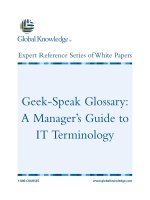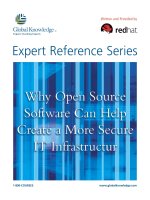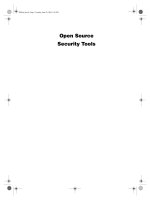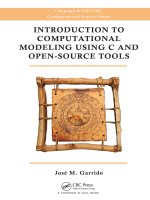java open source programming
Bạn đang xem bản rút gọn của tài liệu. Xem và tải ngay bản đầy đủ của tài liệu tại đây (6.42 MB, 482 trang )
www.it-ebooks.info
Joe Walnes
Ara Abrahamian
Mike Cannon-Brookes
Pat Lightbody
Java
™
Open Source
Programming
With XDoclet, JUnit,
WebWork, Hibernate
01 463620 FM.qxd 10/28/03 8:49 AM Page i
www.it-ebooks.info
01 463620 FM.qxd 10/28/03 8:49 AM Page xii
www.it-ebooks.info
Joe Walnes
Ara Abrahamian
Mike Cannon-Brookes
Pat Lightbody
Java
™
Open Source
Programming
With XDoclet, JUnit,
WebWork, Hibernate
01 463620 FM.qxd 10/28/03 8:49 AM Page i
www.it-ebooks.info
Vice President and Executive Group Publisher: Richard Swadley
Vice President and Executive Publisher: Bob Ipsen
Vice President and Publisher: Joseph B. Wikert
Executive Editorial Director: Mary Bednarek
Editorial Manager: Kathryn A. Malm
Executive Editor: Robert Elliott
Senior Production Editor: Fred Bernardi
Development Editor: Kevin Shafer
Production Editor: Pamela Hanley
Media Development Specialist: Kit Malone
Permissions Editor: Carmen Krikorian
Text Design & Composition: Wiley Composition Services
Copyright © 2004 by Wiley Publishing, Inc., Indianapolis, Indiana. All rights reserved.
Published simultaneously in Canada
No part of this publication may be reproduced, stored in a retrieval system, or transmitted in any form
or by any means, electronic, mechanical, photocopying, recording, scanning, or otherwise, except as
permitted under Section 107 or 108 of the 1976 United States Copyright Act, without either the prior
written permission of the Publisher, or authorization through payment of the appropriate per-copy fee
to the Copyright Clearance Center, Inc., 222 Rosewood Drive, Danvers, MA 01923, (978) 750-8400, fax
(978) 646-8600. Requests to the Publisher for permission should be addressed to the Legal Department,
Wiley Publishing, Inc., 10475 Crosspoint Blvd., Indianapolis, IN 46256, (317) 572-3447, fax (317)
572-4447, E-mail:
Limit of Liability/Disclaimer of Warranty: While the publisher and author have used their best efforts
in preparing this book, they make no representations or warranties with respect to the accuracy or
completeness of the contents of this book and specifically disclaim any implied warranties of mer-
chantability or fitness for a particular purpose. No warranty may be created or extended by sales rep-
resentatives or written sales materials. The advice and strategies contained herein may not be suitable
for your situation. You should consult with a professional where appropriate. Neither the publisher
nor author shall be liable for any loss of profit or any other commercial damages, including but not lim-
ited to special, incidental, consequential, or other damages.
For general information on our other products and services please contact our Customer Care Depart-
ment within the United States at (800) 762-2974, outside the United States at (317) 572-3993 or fax
(317) 572-4002.
Trademarks: Wiley and the Wiley Publishing logo are trademarks or registered trademarks of John
Wiley & Sons, Inc. and/or its affiliates in the United States and other countries. Java is a trademark of
Sun Microsystems, Inc. All other trademarks are the property of their respective owners. Wiley Pub-
lishing, Inc., is not associated with any product or vendor mentioned in this book.
Wiley also publishes its books in a variety of electronic formats. Some content that appears in print
may not be available in electronic books.
Library of Congress Cataloging-in-Publication Data:
Java Open source programming : with Xdoclet, JUnit, WebWork, Hibernate
(Java Open Source Library) / Joe Walnes [et al.].
p. cm.
ISBN 0-471-46362-0 (PAPER/WEBSITE)
1. Java (Computer program language) 2. Open source software. I.
Walnes, Joe, 1978-
QA76.73.J38J3785 2003
005.2'762 dc22
2003020242
ISBN: 0-471-46362-0
Printed in the United States of America
10 9 8 7 6 5 4 3 2 1
01 463620 FM.qxd 10/28/03 8:49 AM Page ii
www.it-ebooks.info
Contents
iii
Acknowledgments xiii
About the Authors xv
Introduction xvii
Part One Introduction 1
Chapter 1 Overview of the Book 3
Using Open Source Technologies 3
Understanding Design and Development Philosophies 5
Test First 5
Less Is More 5
Always Ask the Dumb Questions 6
Exploring the PetSoar Project 6
Sticking to the Basics 7
Summary 7
Chapter 2 Application Overview 9
Looking at Yet Another Pet Store? 9
Understanding the Importance of Maintainability 11
Understanding the Requirements of PetSoar 11
Examining the Architecture and Technologies 12
Looking at the Architecture 12
Looking at Utility Libraries 14
Using Persistence and Searching 14
Using the Web Front End 15
Testing 16
Summary 16
01 463620 FM.qxd 10/28/03 8:49 AM Page iii
www.it-ebooks.info
Part Two Building Your Open Source Toolbox 17
Chapter 3 Unit Testing with JUnit 19
Types of Testing 19
Using JUnit 20
Features of JUnit 21
Writing a Unit Test 21
Running a Unit Test 23
Running Multiple Tests 25
Everything You Need to Know about JUnit 28
Assertion Methods 28
Exception Handling 29
Test Suites 30
Test Runners 30
Setting Up and Tearing Down the Environment 34
Extensions 37
Summary 38
Chapter 4 Testing Object Interactions with Mocks 39
Testing Object Interactions 39
Exploring Some Pitfalls of Testing State 39
Too Many Dependencies 40
Too Much Exposure 40
Too Much State to Manage 40
Too Hard to Test 41
Exploring the Alternative: Testing Interactions 41
Using Mock Objects 42
Example Scenario 43
Understanding the Role of a Mock Object 44
Understanding the Mock Objects Library 45
Using Dynamic Mocks 46
Creating Mocks 47
Substituting Objects 47
Defining the Expectations 48
Understanding Argument Constraints 48
Verifying Expectations 49
Setting Up Return Values 50
Summary 51
Chapter 5 Storing Objects with Hibernate 53
Understanding the Complexities of Persistence 53
Persisting Objects with Hibernate 2 54
Creating the Persistent Classes 55
Mapping the Classes to a Database 57
<hibernate-mapping> 58
<class> 58
<property> 59
<id> 59
<component> 60
iv Contents
01 463620 FM.qxd 10/28/03 8:49 AM Page iv
www.it-ebooks.info
Configuring Hibernate 60
Obtaining a Session 63
Storing Objects in the Database 64
Retrieving Objects from the Database 67
Querying Persistent Objects 68
Persisting Relationships Between Objects 70
Persisting Hierarchies of Objects 76
Understanding the Hibernate Toolset 79
Comparing Hibernate with Competing Technologies 79
Hibernate vs. EJB 79
Hibernate vs. JDO 81
Hibernate vs. DAO Frameworks 81
Summary 81
Chapter 6 Model View Controller with WebWork 83
Understanding Model View Controller (MVC) 83
Examining the Model Layer 84
Examining the View Layer 85
Examining the Controller Layer 85
Tying It All Together 85
Looking at Reasons to Use MVC 86
Understanding MVC, WebWork, and XWork 87
Exploring XWork 87
Exploring WebWork 88
Taking an In-depth Look at Actions 89
A Simple XWork Example 90
Configuring XWork 91
Structuring Your Actions (Action Composition) 91
Calling an Action from XWork 93
Using Parameters and the ActionContext 94
Applying Newton’s Third Law of Physics 95
Understanding XWork Results and Action Chaining 96
Examining WebWork Results and the Servlet Environment 96
Configuring WebWork 98
Understanding the Role of the Dispatcher 99
Namespaces 100
Exploring Example Views in JSP and Velocity 101
HelloWorld in JSP 101
JSP Tags 102
Looking at Component-Based Web Development 104
Themes 107
Writing Your Own Component 108
One Small Problem 108
Expressing Yourself 109
Using Basic Expressions 110
Properties 110
Method Calls 111
Static Fields and Method Calls 111
Contents v
01 463620 FM.qxd 10/28/03 8:49 AM Page v
www.it-ebooks.info
Using Advanced Expressions 111
Dealing with Collections 112
Constructors 113
Context Variables and the Root Variable 113
Understanding the ValueStack 113
Accessing Stack Elements 114
Examples Using the JSP Tags 114
Exploring Type Conversion 115
Digging into a Date Example 115
Specifying Default Conversion Rules 117
Specifying New Conversion Rules 117
Separating Concerns with Interceptors 118
Looking at Configuration and Interceptor Stacks 118
Using LoggingInterceptor 119
Building Your Own Interceptor 120
Validation — A Powerful Interceptor 120
Exploring an Example without XWork Validation Framework 120
Exploring an Example with XWork Validation Framework 122
Using Built-In and Custom Validators 123
Using the Expression Validator 125
Summary 125
Chapter 7 Simplifying Layout with SiteMesh 127
Identifying Problems with Layout 127
Using the Object-Oriented Solution 132
Decorator Design Pattern 133
Composite Design Pattern 134
Combining the Patterns 135
Implementing the Solution with SiteMesh 137
SiteMesh Fundamentals 138
Creating a Decorator 140
Composing Pages 142
Exploring SiteMesh 145
Getting to the Content 145
Mapping Decorators 148
Using Tips and Tricks 149
Group Decorators Together 150
Don’t Be Afraid to Include 150
CSS Is Your Friend 150
Minimize HTML 151
Separate Your Concerns 151
Summary 151
Chapter 8 Adding Search Capabilities with Lucene 153
Understanding the Complexities of Searching 153
Introducing Lucene 154
Understanding the Elements of Lucene 154
Indexing a Document 155
vi Contents
01 463620 FM.qxd 10/28/03 8:49 AM Page vi
www.it-ebooks.info
Searching Documents 159
Reindexing and Removing an Indexed Document 161
Using Advanced Searching 161
Customizing the Tokenization Process 162
Summary 164
Chapter 9 Generating Configuration Files with XDoclet 165
Introducing XDoclet 165
Understanding Attribute Oriented
Programming with XDoclet 166
Understanding the Syntax of Attributes 168
Running XDoclet 170
Using Advanced Hibernate OR Mapping with XDoclet 173
Using XDoclet for Generating More Sophisticated Artifacts 175
Understanding XDoclet Tasks and Subtasks 179
EJBDoclet 179
WebDoclet 180
JMXDoclet 180
JDODoclet 180
HibernateDoclet 181
Using XDoclet Effectively 181
Summary 183
Chapter 10 Communication and Tools 185
Exploring PetSoar Development 185
Managing Imperfect Communication 188
Communicating in Every Way 188
Using Source Communication 189
Using Communication as a Learning Tool 190
Exploring Our Toolbox 191
Source Configuration Management — CVS 191
Knowledge Management — Wiki 191
Mailing List — Majordomo 192
Real-time Discussion — IRC and Instant Messaging 192
IDEs — IDEA and Eclipse 193
Issue Tracking and Task Management — JIRA 193
Using Continuous Integration 193
Tying the Tools Together 195
Summary 195
Chapter 11 Time-Saving Tools 197
Understanding Utility Components 197
Understanding OSCache 198
Introducing SampleNews.com 198
Using the Loop Test 199
Exploring the OSCache Tag Library 201
Understanding OSCache Concepts 202
Cache Key 202
Scope 202
Duration 203
Contents vii
01 463620 FM.qxd 10/28/03 8:49 AM Page vii
www.it-ebooks.info
Looking at a Caching Time Example 203
Looking at Advanced OSCache Features 204
Caching Binary content 205
Java API 205
Error Tolerance 205
Disk Persistence 205
Understanding Commons Lang 205
Exploring Most Useful Classes 206
Using Builder Classes 206
Understanding Commons Collections 209
Understanding Commons Logging 211
Looking at Advantages of Commons Logging 211
Looking at a Simple Example 212
Understanding Commons Digester 213
Looking at a Digester Example 213
Understanding Digester Rules 216
Summary 217
Part Three Developing the Application 219
Chapter 12 Setting Up the Development Environment 221
Working from Within the IDE 222
The Problem: IDEs Don’t Automate 223
The Solution: Automated Build Tools 224
Using Ant for All Your Building Needs 225
The Problem: Ant Isn’t the Silver Bullet 225
The Solution: Use What Makes Sense 225
Using the Hybrid Approach 225
Laying Out Your Project 227
Structuring by Type 227
Structuring by Deployment 229
Picking a Structure 230
And What about PetSoar? 230
Managing Unit Tests 231
Understanding Test Types 232
Examining Test Suites, JUnit, and Batch Testing 233
Using Version Control 234
Deploying PetSoar 235
Summary 237
Chapter 13 Understanding Test Driven Development 239
Why Test First? 240
Testing First vs. Testing Last 240
Tests as Documentation 241
Software Design Through Test Driven Development 242
Narrowing the Requirements 242
Understanding Testing Techniques 243
Place Unit Tests in the Same Package As Your Code 244
Never Skip Failing Tests 244
Isolate the Untestable Using Mock Objects 244
viii Contents
01 463620 FM.qxd 10/28/03 8:49 AM Page viii
www.it-ebooks.info
When to Use Interfaces and Classes 245
Stick with Simplicity 245
Work from the Top Down 246
Use Lots of Small Objects 246
Ensure That Your Test Suite Runs Quickly 247
Avoid Statics and Singletons 247
Testing the TDD Cycle 247
Example Scenario Using TDD 249
Step 1 249
Step 2 249
Step 3 250
Step 4 251
Example Scenario Revisited 251
Step 1 251
Step 2 251
Step 3 252
Step 4 252
Enhancing the Functionality 252
Step 1 252
Step 2 253
Step 3 253
Step 4 254
Summary 254
Chapter 14 Managing Lifecycles and Dependencies of Components 255
Understanding Components and Services 255
Handling Dependencies 256
Using Direct Instantiation 256
Using a Factory 257
Using a Registry 257
Using a Container 258
Understanding the Component Lifecycle 259
Understanding Inversion of Control 260
Examining the Benefits 260
Exploring the Disadvantages 261
Understanding Separation of Concerns 262
Using Containers to Define Scope 262
Using XWork’s Container Implementation 263
Configuring the Container 263
Understanding How the Container Works 264
Testing XWork Components 266
Summary 268
Chapter 15 Defining the Domain Model 269
Considering the Advantages of a Domain Model 269
Tackling the Layers 270
Comparing a Layer-Driven vs. Feature-Driven Approach 270
Choosing Bottom Up, Top Down, or Middle Out 272
Contents ix
01 463620 FM.qxd 10/28/03 8:49 AM Page ix
www.it-ebooks.info
Identifying the Current Goal 275
Adding a Pet to the Store 275
Implementing the PersistenceManager Using Hibernate 279
Where We Are 288
Retrieving Pets 289
Retrieving a Single Pet 292
Where We Are 295
Persisting the Categories 297
Where We Are 300
Implementing the Category-Pet Relation 301
Where We Are 306
Performance and Maintainability Considerations 306
Summary 308
Chapter 16 Creating a Web-Based Interface 309
Adding a Pet 310
Creating the AddPet Action 310
Creating Views for AddPet 313
Tying It All Together 315
Displaying a Pet 317
Creating the ViewPet Action 317
Refactoring the Actions 321
Editing a Pet 324
Checking Validity 327
Tying It All Together — Take II 328
Get that Pet Out of Here! 329
Refactoring the CRUD 333
Removing Duplication in ViewPet and RemovePet 334
Odd One Out 336
Performing One Last Refactor 338
Decoupling the Validation 340
Changing the Pet 343
Summary 345
Chapter 17 Defining Navigation, Layout, Look, and Feel 347
Componentizing Form Widgets 347
Forming a Better Look and Feel 351
Using a Touch of Style 355
Navigating to a Better User Interface 358
Summary 361
Chapter 18 Implementing Browse and Search Capabilities 363
Defining the Application Requirements 363
Browsing the List of Categories 364
Browsing the List of Pets 366
Searching the Store for Pets 369
Implementing LuceneSearcher 372
Implementing LuceneIndexer 376
Where We Are 386
x Contents
01 463620 FM.qxd 10/28/03 8:49 AM Page x
www.it-ebooks.info
Implementing Searching of Any Type of Data 386
Where We Are 395
Implementing Full-Text Searches 395
Implementing Pagination 397
Tying It All Together 401
Summary 403
Chapter 19 Adding a Shopping Cart 405
Creating a Shopping Cart 405
Creating the WebWork Actions 408
Checking Out the Shopping Cart 411
Summary 423
Chapter 20 Securing the Application 425
Understanding J2EE Security 426
Simplifying Security 428
Using the HTTP Request Wrapper 429
Using the Security Filter 430
Using the Login Filter 430
Making It All Work in Harmony 432
Using a More Graceful Approach 434
Summary 436
Index 437
Contents xi
01 463620 FM.qxd 10/28/03 8:49 AM Page xi
www.it-ebooks.info
01 463620 FM.qxd 10/28/03 8:49 AM Page xii
www.it-ebooks.info
Martin Fowler, despite being busy with his own book, proved invaluable with
his improvements and guidance along the way. Ben Hogan and Erik Hatcher
managed to consistently provide us with an awesome amount of feedback
with little notice. Dan North requires a special mention for not only providing
great reviews but for saving us in the eleventh hour by helping to rewrite a
chapter. Special thanks to Gavin King for fast and accurate review of the
Hibernate-related chapters in the final periods of the book.
Of course, this book would be nothing without the patience of our many
reviewers: Andy Pols, Aslak Hellesoy, Damian Guy, Darren Hobbs, Hooman
Mehr, Ivan Moore, Jason Carriera, Jeremy Stell-Smith, Lisa Van Gelder, Math-
ias Bogaert, Matt Ho, Mike Roberts, Mike Royle, Owen Rogers, Rachel Davies,
Rachel McConnell, Rebecca Parsons, Scott Farquar, Steve Freeman, and Tim
Mackinnon.
Rickard Oberg and Matt Baldree also played an important role in the cre-
ation of this book. Without them, we would never have gotten started.
We would also like to thank the teams behind the Open Source tools that we
used, for providing those excellent tools and responding to our requests. We
thank Bob and the rest of the team at Wiley for constantly supporting us.
Mike would like to thank his co-authors, the Atlassian development team
(Scott, Owen, Anton, Jeff, Bobby, Dave, Edwin); his “work” mates (Mike,
Gavin, Jason, Jeremy, Eugene, Rickard and more); his Sydney mates (Niki,
Alina (Kins), Sarah, Camilla, Will, Hoey, Tex, Kel, Nuts, et al — you know who
you are) and, last, but certainly not least, his family (Mum, Dad, Jace, Tora,
Andrew, James, Holly, and little Phoebe). He’d also like to thank anyone who
read the previous sentence and is still searching for his or her name — he for-
got you and apologizes profusely.
Acknowledgments
xiii
01 463620 FM.qxd 10/28/03 8:49 AM Page xiii
www.it-ebooks.info
Joe would like to thank all his fellow ThoughtWorkers; it’s a humbling expe-
rience working with them. Special thanks to Dan North for encouraging him
to reach that bit further (not just the top magazine rack) while keeping his feet
on the ground. Paul Hammant always looks out for him and provides solid
experiences that have driven his techniques. Paul, Dan, Laura Waite, and Tim
Bacon have always been there for him when he needed them and have been
excellent coaches, mentors, and friends. Charles Lowell, Chris Stevenson,
Drew Noakes, Duncan Cragg, Gregor Hohpe, Jeremy Stell-Smith, Jonathan
Rasmusson, Martin Fowler, Mike Roberts, and Tim Mackinnon have been a
constant inspiration to work with, amongst many other names. Thanks to
Trevor Mather for the support and for not being what Dan said you’d be.
Joe thanks his family (Mum, Gay Dad and Tilly) for the support. Most
important, Joe thanks his loving fiance, Jaimie, for sticking by and loving him
all the way through the ordeal. Right back at ya!
Ara would like to thank his co-authors; he learned a lot from them during
writing the book. He would also like to thank his colleagues at Eedé and Rox-
cel (Behrang, Nazanin, Iman, Arbi, Nassim, Ali, Ramin, Mohammad and Dr.
Mohammad, Jarek, and Mr. Lehmann) for their support; especially his creative
ex-boss (Hooman) and Dr. Arsanjani (his first coach in software development
techniques); and his best friends (Teodik, Armond, Farzad, Raymond, Telma,
Abtin, Artin, Arin, Nasser, and Ali). Without your support and encourage-
ment, it would have been impossible to engage in such a long and huge proj-
ect. He thanks his family (Mom, Dad, Razmik, Emma, Alice, Seda, and
Narbeh) for their support. Ara loves you all!
Pat would like to thank all his co-workers at Cisco and Spoke who helped
him along the way. Special thanks to Mike Schwartz for his extra effort in pro-
viding invaluable feedback. He’d also like to thank Adam Fleming, Marshal
Dhillon, Michael Artamonov, and Dan Libicki for their willingness to subject
themselves to the ideas presented in this book in a first-hand experience. A
very special thanks goes out to Professor Bill Griswold for being a great
teacher and having a strong influence on this book. Finally, he would like to
thank his friends and family for supporting him throughout the writing
process. Mom, Dad, Chris — you’re the best!
xiv Acknowledgments
01 463620 FM.qxd 10/28/03 8:49 AM Page xiv
www.it-ebooks.info
Joe Walnes is a consultant for ThoughtWorks (www.thoughtworks.com), a
systems integration company that specializes in Agile development tech-
niques for the enterprise. His areas of expertise lie in Extreme Programming
coaching for developers, design techniques for object-oriented and compo-
nent-oriented systems, and simplifying J2EE development. In his (minimal)
spare time, he works on Open Source projects, many of which can be found at
www.opensymphony.com and www.codehaus.org.
You can read his blog at: .
Ara Abrahamian is a freelance consultant specializing in developing Enter-
prise Java solutions. He’s been involved in various J2EE projects all around the
globe, as a consultant or technical leader. His areas of expertise are code gen-
eration, attribute-oriented programming, and software automation tech-
niques. He is also active in many Open Source projects, including XDoclet as
the leader of the project. His other area of interest is adapting lightweight
methodologies such as XP to large distributed teams.
You can read his blog at: />Mike Cannon-Brookes is the founder of Atlassian (www.atlassian.com), a
cutting-edge J2EE applications and services company in Sydney, Australia.
Atlassian makes top-class J2EE software applications including JIRA, a leading
issue-tracking and project-management system. Mike specializes in building
brilliantly simple, usable J2EE Web applications and also founded JavaBlogs
(www.javablogs.com), a Web-based, Java-focused blog aggregator. He also
founded the OpenSymphony (www.opensymphony.com) project and works
on WebWork, SiteMesh, and other Open Source projects. On weekends, he likes
to be distinctly Australian — drinking, gambling, and enjoying the best coun-
try on earth.
You can read his blog at: />About the Authors
xv
01 463620 FM.qxd 10/28/03 8:49 AM Page xv
www.it-ebooks.info
Pat Lightbody currently lives in San Francisco and works in Palo Alto at a
startup company called Spoke Software, which specializes in enterprise soft-
ware using social networking to enhance sales performance. Before that, he
worked as a software engineer at Cisco Systems and attended the University
of California, San Diego, where he received his B.S. in Computer Science. He
also works on various Open Source projects, primarily WebWork, XWork, and
OSWorkflow, all of which can be found at www.opensymphony.com.
You can read his blog at: />xvi About the Authors
01 463620 FM.qxd 10/28/03 8:49 AM Page xvi
www.it-ebooks.info
In today’s IT environment, Java is a leading technology in the world of enter-
prise development. As management demands more from technology, com-
plexity in infrastructure seems to grow exponentially, leaving many unable to
keep up with the demands of such a fast-paced world. These complexities
can be seen in the over-evolving Java 2 Enterprise Edition (J2EE) specifica-
tions. This unnecessary complexity drove us to discover ways of simplifying
development.
Now, don’t get us wrong; we love J2EE! But why does it take so long to get
stuff done? We (the authors of this book) were all early adopters of J2EE, grap-
pling with concepts and complexities as they evolved. It was painful, but over
time, we started making use of reusable Open Source tools that dramatically
reduced the time taken to develop these applications. We also started ques-
tioning which technologies were actually helping us and which had become a
hindrance.
This book is about using development techniques and Open Source tools to
lower the cost of building enterprise applications. We aim to show you how to
bring these together to build a real-world application while avoiding com-
plexity and embracing simplicity. We will help you extend your knowledge of
Java and the J2EE framework so that you can begin using the millions of dol-
lars of free research and development just waiting to be utilized.
Not only will this book teach you how to utilize Open Source technology
that you can put to work for you immediately; it will also strengthen and
broaden your development philosophies in such a manner that, like us, you
will soon find yourself scratching your head in wonder and asking “Why
didn’t I do this a long time ago?”
Introduction
xvii
01 463620 FM.qxd 10/28/03 8:49 AM Page xvii
www.it-ebooks.info
Why You Need This Book
This book takes on two goals that will benefit you both immediately and in the
future:
■■
The most immediate goal is that you will become more familiar with
just a few of the hundreds of amazing Open Source technologies avail-
able for use.
■■
Furthermore, the simple techniques and philosophies we shall intro-
duce will be applicable today and long into the future, even when
current technologies may have been replaced by better alternatives.
We shall apply these technologies and techniques by recreating Sun’s Java
Blueprint: the infamous PetStore application. Our implementation of the Pet-
Store will not be an exact carbon copy, but rather an improvement all around,
in terms of usability, architecture, and simplicity. We call this project PetSoar
because the development of the projects just soars along. Outlined here are the
various technologies and skills that are presented throughout this book.
Who Should Read This Book?
Just as this book has two major goals, technology and techniques, there are
also two groups of readers that this book caters to (although usually these two
groups actually consist of the same set of people).
The first group consists of anyone who wishes to learn about cutting-edge
Open Source Java components. In this book, we will take an in-depth look into
several prominent Open Source projects that aid in enterprise development,
including JUnit, Ant, Hibernate, WebWork, SiteMesh, XDoclet, and Lucene. If
you’re not already familiar with these projects, odds are you’re at least famil-
iar with the problems they are trying to solve. We will show both the problems
that each tool addresses, as well as give you a step-by-step guide to using these
tools in a real-world application.
The second group consists of anyone who has grappled firsthand with proj-
ect complexities spinning out of control. We’ve found that these complexities
are actually the result of developers thinking that complex requirements
require complex solutions. Instead, in this book, we will show you how to
apply the principle of simplicity to achieve your goals in the shortest amount
of time. We will do this by following the development of the PetSoar applica-
tion using Test Driven Development (TDD), a practice that exudes the idea that
less is more.
Conventions
In this book, we use various methods of calling text out to you for different
reasons. For example, when we want you to type something, we bold the text
xviii Introduction
01 463620 FM.qxd 10/28/03 8:49 AM Page xviii
www.it-ebooks.info
that we want you to type, as in “Type ls -l and press Enter.” When we mention
commands, filenames, or directories, we use what’s called monofont (or a
fixed-width font) to call out the text of that item. For example, “As you can see,
the ls command lists two files: fileone.txt and filetwo.lgz, both of
which are located in the directoryone directory.”
How This Book Is Organized
This book is divided into three distinct parts, with the majority of the content
in Parts II and III.
Part I: Introduction
The first part of the book will serve as a roadmap to what we plan to discuss in
the rest of the book. Here we will introduce the tools we are going to cover as
well as discuss the PetSoar application overview and architecture.
Part II: Building Your Open Source Toolbox
The second part of the book will introduce you to the many Open Source pro-
jects that we have come to include in our “developer’s toolbox” over the years
of working with J2EE. We will discuss reasons why each technology is useful,
lessons learned from using the product, and finally alternative Open Source
projects that may offer similar or complementary functionality.
Part III: Developing the Application
The last part of the book is dedicated entirely to using these Open Source pro-
jects to implement various features required by the PetSoar project. In these
chapters, we will also formally introduce you to the development philoso-
phies outlined here and show you how you can successfully meld them into
your professional career, resulting in incredibly successful applications. This
part shows how the technologies and techniques come together to deliver an
application.
While the book has been designed to be read linearly, we know that, because
we are writing to several different audiences, some of you may skip certain
chapters or parts of this book. If you are already a power-user of a particular
technology described in Part II, you can easily skip that section. Or, if learning
a particular tool is all you want to do, head straight for Part II. Or if you are
building an enterprise application that is not Web-based, you can skip the
appropriate chapters in Part III.
Introduction xix
01 463620 FM.qxd 10/28/03 8:49 AM Page xix
www.it-ebooks.info
Beyond the Book
This book gives you a good start on Open Source tools as well as building real
applications while focusing on simplicity, but the help doesn’t end here. For
starters, this book has a companion Web site that’s located at the following
URL:
/>Featured at the site are:
■■
The PetSoar application ready for download for you to try out on your
own personal machine
■■
Any updates and addendums to the book itself
■■
A mailing list to discuss the tools and techniques used in this book with
the authors and other readers
■■
Technology updates to help you keep pace with the advancements in
the tools and technology since publication time
Also, consider checking out J2EE Open Source Toolkit: Building an Enterprise
Platform with Open Source Tools by John T. Bell, James Lambros, and Stan Ng
(John Wiley & Sons: Hoboken, NJ, 2003), another title in the Java Open Source
Library that shows you how to build an enterprise development platform
using Open Source tools, including many of the same tools discussed in this
book. We’ll refer occasionally to that book in this one.
xx Introduction
01 463620 FM.qxd 10/28/03 8:49 AM Page xx
www.it-ebooks.info
PART
One
Introduction
In Part I, we provide a brief introduction of what you can expect throughout
the rest of the book. This is divided into two core sections: Open Source tools
and application development techniques. In Chapter 1, we provide you
with an overview of the tools detailed in this book and then discuss the
philosophies you can expect to see championed. In Chapter 2, we tie those
tools together with the development philosophies by discussing the general
architecture taken to build the PetSoar application. By the end of these two
chapters, you should have a clear idea of what to expect for the remainder
of the book.
02 463620 pp01.qxd 10/28/03 8:49 AM Page 1
www.it-ebooks.info
02 463620 pp01.qxd 10/28/03 8:49 AM Page 2
www.it-ebooks.info









